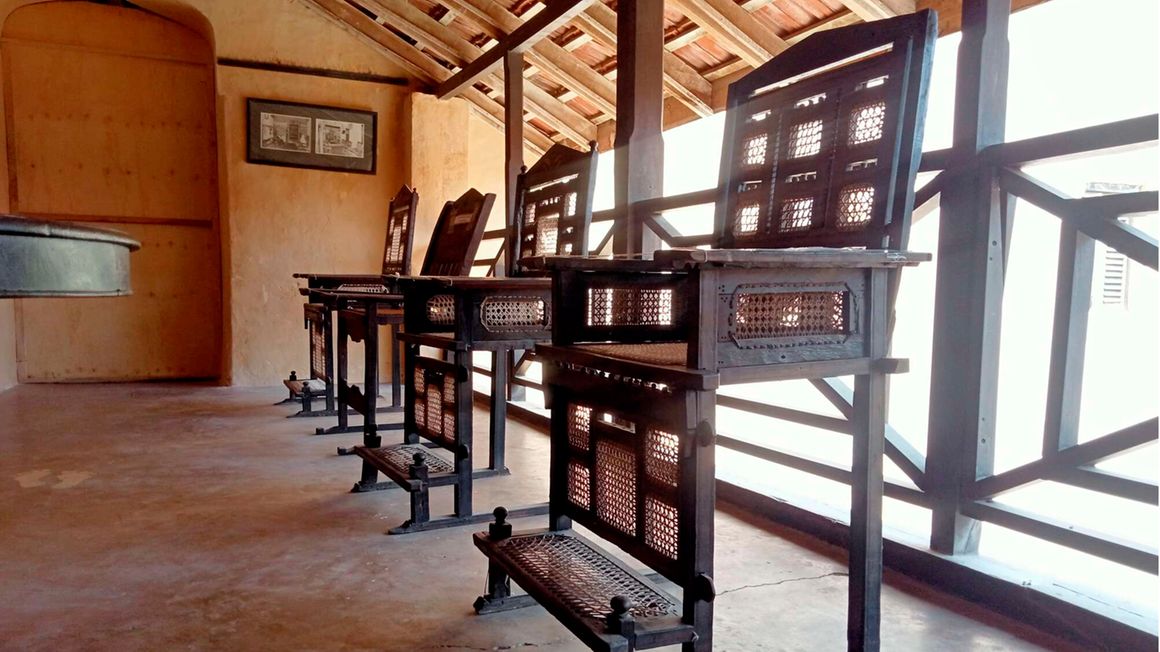
Versions of Kiti Cha Enzi which translates to 'Chair of Power' on display at the Lamu Fort Museums. PHOTO | KALUME KAZUNGU | NMG
Lamu, at its zenith, was an important centre for various powers, both local and foreign going back to the 12th century. It was a melting pot of cultures whose artefacts remain to date.
Among the best-preserved items is the Kiti Cha Enzi, or ‘Chair of Power,’ also known as the ‘grandees’ chair which is valued amongst the Swahili people.
Kiti cha Enzi has existed for over 500 years and is today part of the unique culture and heritage of the Swahili communities living in Lamu and along the Kenyan Coast.
National Museums of Kenya (NMK) Curator in charge of Lamu Museums and World Heritage site, Mohammed Ali Mwenje defines Kiti Cha Enzi as a high-backed seat with bone and ivory inlay.
The earliest Kiti cha Enzi can be traced to the 15th century. Most of those in existence today are from the 19th century, Mr Mwenje points out adding that originally, the chair was associated with the wealthy Swahili.
READ: Takwa Ruins: The abandoned Swahili city with a rich Portuguese influence
The chair is constructed using finely crafted pieces of hardwood that are pegged together and carefully labelled with hash marks so that they can be disassembled.
Unlike other chairs, the Kiti cha Enzi is embellished with delicate inlay in bone and ivory, and decoratively woven string fills the open spaces on its back, seat, and footrest.
Mr Mwenje says the Swahili version of Kiti Cha Enzi (Chair of Power) is the result of foreign influences that have been artfully synthesised and reshaped by local artisans.
“This is a unique chair invented hundreds of years ago that is commonly found in our furniture collections at the Lamu Museum today. It’s part of the Swahili heritage. Most such chairs in our collections were made in large, specialized workshops.
The chair's artistic and decorative elements are generally a graphic reminder of the complex history of international trade and conquest in the region, involving the Omani, Indians, Portuguese, and later the British.
With each conquering state, newly imported goods and practices took root as symbols of authority and power among the Swahili elite.
“Therefore, I can connect the upright form of the Kiti Cha Enzi as something that bears a strong resemblance to 16th and 17th-century chairs imported from Portugal and Spain, as well as to Portuguese- and Spanish-influenced examples made in India,” says Mr Mwenje.
According to Lamu Museum records, comparisons of the Kiti Cha Enzi were also made with chairs from the Mamluk period (1250–1517) in Egypt.
“My stand is still that this chair was used by almost every household. The only elements that differentiate it from the wealthy or mighty and the normal users are the size and the level of decorations for that particular chair used,” notes Mr Mwenje.
Ali Skanda, a renowned carpenter, and designer of Kiti Cha Enzi in Lamu says materials used in making the seat can also determine whether one is wealthy, poor, high, or of low status.
Mr Skanda says high-quality chairs reserved for high-class people are always made of superior-quality woods such as ebony and mahogany and they are always more elaborately decorated with ivory or camel bones.
“The simple Kiti Cha Enzi chairs are made of low-quality wood like mvule and many times less decorated with cow bones used,” notes Mr Skanda.
The price for a single Kiti Cha Enzi varies from Sh50,000 to Sh200,000.
READ: Kenya eyes Muslim visitors with Lamu's Maulid Festival
“In the olden days, we even used to have high chairs that could be bought for as high as Sh500,000 especially if ivory is used. But today, ivory is no longer accepted and we’ve replaced it with camel and cow bones,” says Mr Skanda.
Today, the functions of Kiti cha Enzi have evolved. Many times it has been used as a ceremonial chair.
Kiti Cha Enzi has in recent times been used to present the bride during Swahili weddings in Lamu.
From the 1970s onwards, the chair has also been seen used in many public, state, or political functions as a reserved seat for the guest of honour, be it the head of state when he visits Lamu, the governor, and other prominent leaders.
→ skazungu@ke.nationmedia.com




No comments :
Post a Comment